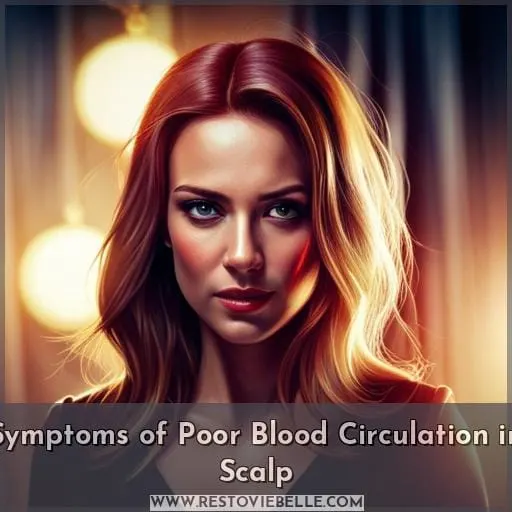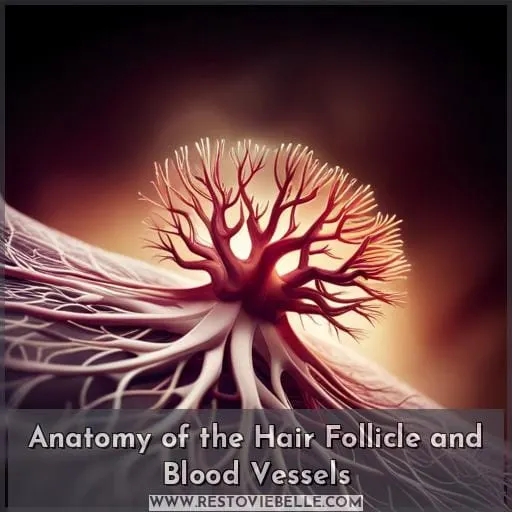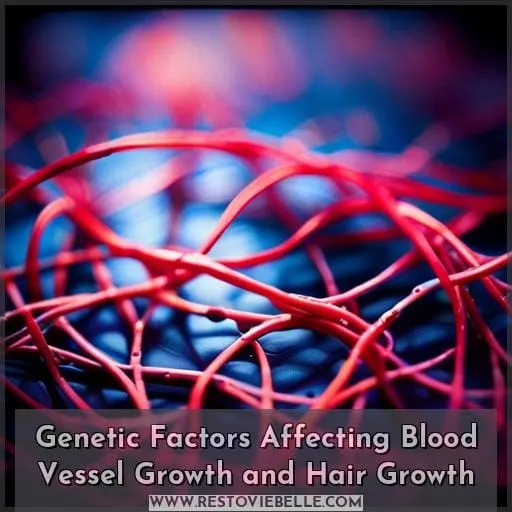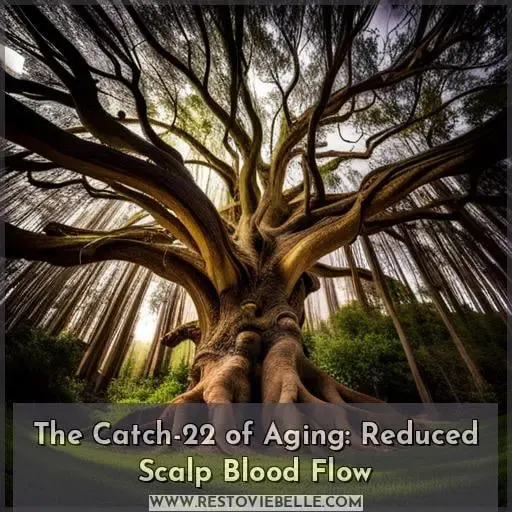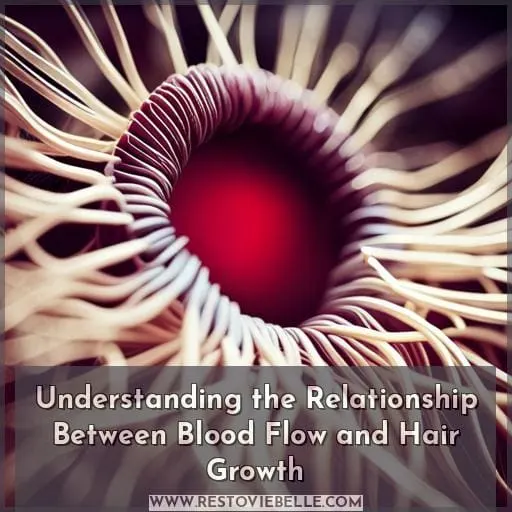This site is supported by our readers. We may earn a commission, at no cost to you, if you purchase through links.
 Imagine having the power to transform your hair by simply increasing blood flow to your scalp. It may sound too good to be true, but it’s a crucial step that is often overlooked. Boosting blood circulation can promote hair growth and improve overall hair health.
Imagine having the power to transform your hair by simply increasing blood flow to your scalp. It may sound too good to be true, but it’s a crucial step that is often overlooked. Boosting blood circulation can promote hair growth and improve overall hair health.
In this article, you’ll discover techniques and remedies for increasing blood flow in your scalp, allowing essential nutrients and hormones to nourish your follicles like never before.
Table Of Contents
- Key Takeaways
- How Does Blood Circulation Affect Scalp & Hair?
- Symptoms of Poor Blood Circulation in Scalp
- Techniques to Increase Blood Circulation in Scalp & Hair
- Anatomy of the Hair Follicle and Blood Vessels
- Genetic Factors Affecting Blood Vessel Growth and Hair Growth
- The Catch-22 of Aging: Reduced Scalp Blood Flow
- Remedies for Increasing Blood Flow in the Scalp
- Understanding the Relationship Between Blood Flow and Hair Growth
- Frequently Asked Questions (FAQs)
- Can poor blood circulation in the scalp lead to hair discoloration or changes in texture?
- Can certain hairstyles or hair products affect blood flow to the scalp?
- Are there any specific nutrients or vitamins that can enhance blood circulation in the scalp?
- Is there a link between stress or anxiety and reduced blood flow to the scalp?
- Can medical conditions such as high blood pressure or diabetes affect blood circulation in the scalp?
- Conclusion
Key Takeaways
- Blood circulation is essential for promoting hair health and preventing hair loss.
- Scalp massage, essential oil massage, and natural remedies like onion juice and apple cider vinegar can increase blood flow to the scalp.
- Techniques such as the inversion method and regular brushing can also stimulate blood circulation to the scalp.
- Maintaining a balanced diet, exercising regularly, and using topical treatments like minoxidil and peppermint oil can further enhance blood flow to the scalp.
How Does Blood Circulation Affect Scalp & Hair?
Improving blood circulation in your scalp and hair has significant effects on their health and growth.
Scalp blood flow plays a crucial role in promoting hair growth, particularly during the anagen phase when the hair follicles are firmly attached to the dermal papilla, which is connected to a network of blood vessels.
Poor blood circulation can lead to inadequate nutrition reaching the hair follicles, resulting in shorter anagen phases and increased hair fall. On the other hand, increased scalp blood flow is associated with decreased hair loss.
Techniques such as scalp massage have been shown to increase horizontal movement of skin surface and stimulate z-direction displacement of subcutaneous tissue, leading to improved nutrient delivery through enhanced vascularization.
By promoting proper scalp blood flow through various methods like massage or dietary changes that support healthy cardiovascular function can help optimize your overall hair health.
Symptoms of Poor Blood Circulation in Scalp
If you’re experiencing excessive hair fall, weak and brittle strands, or lusterless and rough hair, these could be symptoms of poor blood circulation in your scalp.
Poor blood circulation can result in inadequate nutrition to the hair follicles, leading to shorter anagen phases and increased hair loss.
It’s important to address these symptoms by implementing techniques that increase blood flow to the scalp for improved hair health.
Hair fall prevention techniques
If you’re experiencing symptoms of poor blood circulation in your scalp, such as hair fall and weak, brittle hair strands, there are several techniques you can try to prevent further hair loss.
Some effective scalp massage techniques, natural remedies for increased blood flow include derma rolling and using essential oils.
Effective scalp massage techniques
To effectively improve blood circulation in your scalp and combat the symptoms of poor blood circulation, try incorporating regular scalp massage techniques into your hair care routine.
- Apply gentle pressure during the massage to stimulate blood flow.
- Aim for a duration of 5-10 minutes per session and perform it at least 2-3 times a week.
Some benefits of scalp massage include:
- Increased nutrient delivery to hair follicles
- Relaxation
- Improved overall hair health
Natural remedies for increased blood flow
You can naturally improve blood flow to your scalp and combat symptoms of poor circulation by incorporating these remedies into your hair care routine:
| Remedy | Benefits |
|---|---|
| Onion juice | Stimulates blood flow and promotes hair growth |
| Apple cider vinegar | Improves scalp health and increases circulation |
| Green tea | Contains antioxidants that promote healthy blood flow |
Techniques to Increase Blood Circulation in Scalp & Hair
To increase blood circulation in your scalp and hair, there are several techniques you can try.
One effective method is scalp massage, which helps stimulate blood flow to the hair follicles.
The inversion method of hanging your upper body upside down can also encourage a rush of blood to the scalp.
Additionally, regular cleansing of the scalp and brushing your hair can help improve circulation.
Finally, massaging essential oils into the scalp has been shown to promote better blood flow and overall hair health.
Scalp Massage
To improve blood circulation in your scalp and promote healthy hair growth, one effective technique is scalp massage. It has numerous benefits and can be done with various tools for optimal results.
Inversion Method
To increase blood circulation in your scalp and promote better hair health, try the inversion method.
This technique involves lying down with your upper body facing downwards to encourage blood flow to the scalp.
Scalp Cleansing
Start by incorporating scalp cleansing techniques into your hair care routine to increase blood circulation in the scalp and promote improved hair health.
- Scalp detox
- Hair brushing
- Herbal infusions
- Cold showers
- Nutrition impact
Brushing Hair
Brush your hair regularly to improve blood circulation in the scalp and promote healthier hair growth.
Use scalp stimulation techniques and proper brushing techniques for optimal results, enhancing both blood flow and styling benefits.
Essential Oil Massage
Continue promoting blood circulation in your scalp and hair by incorporating essential oil massage techniques.
Choose carrier oils like coconut or almond, and create DIY massage blends with aromatic benefits using essential oil combinations.
Anatomy of the Hair Follicle and Blood Vessels
To understand the relationship between blood flow and hair growth, it’s important to delve into the intricate anatomy of the hair follicle and its network of blood vessels.
The hair follicle is situated in the lower part of dermis, at the border of dermis and subcutaneous fat tissue. It consists of stem cells located in the bulge area, as well as a rich vascular plexus that surrounds its lower third.
This network connects to a complex system of blood vessels and capillaries within your scalp.
The hair cycle stages include anagen (growth phase), catagen (detachment phase), and telogen (resting phase). Factors such as stem cell dynamics, hormone sensitivity (such as to dihydrotestosterone or DHT), chemotherapy effects on blood flow reduction, as well as techniques like scalp cooling can all impact these cycles by influencing scalp circulation.
Genetic Factors Affecting Blood Vessel Growth and Hair Growth
Genetic factors play a significant role in blood vessel growth and hair growth.
One important gene that affects blood vessel growth is the VEGF gene, which produces a protein that stimulates the formation of blood vessels.
Another genetic factor is related to the length of the hair’s growth stage, known as anagen phase. Certain genes can influence how long this phase lasts, ultimately affecting overall hair health and thickness.
Blood Vessel Growth Gene
To understand the genetic factors that influence blood vessel growth and hair growth, it’s important to explore the role of the Blood Vessel Growth Gene.
This gene plays a crucial role in regulating vascular development and maintenance, which directly affects scalp health and hair growth.
By understanding how this gene impacts blood flow genetics, we can gain valuable insights into improving scalp circulation for healthier hair.
Longer Growth Stage Gene
Now let’s delve into the genetic influences that impact both blood vessel growth and hair growth, with a specific focus on the longer growth stage gene.
This gene plays a crucial role in determining the length of time that your hair remains in its active growing phase, known as the anagen phase.
Genetic factors can interact with various lifestyle impacts, such as nutrition and environmental factors, to affect blood vessel development and ultimately influence hair health.
Hormonal effects also play a significant role in this complex interplay of genetic and environmental factors.
The Catch-22 of Aging: Reduced Scalp Blood Flow
As you age, the blood flow to your scalp decreases, creating a catch-22 situation for hair health.
Aging is known to have an impact on circulation throughout the body, including the scalp. Reduced blood flow means that less oxygen and nutrients are delivered to the hair follicles, which can result in weaker and thinner hair strands.
Furthermore, certain medications can also affect circulation and contribute to decreased blood flow in the scalp. Hormonal changes during menopause can also lead to reduced blood supply to follicles in women.
Additionally, cancer treatments such as chemotherapy may cause a decrease in scalp blood flow due to their targeted effects on rapidly dividing cells like those found within hair follicles.
Overall lifestyle factors such as poor diet or lack of exercise can further exacerbate reduced scalp circulation with aging.
Remedies for Increasing Blood Flow in the Scalp
To increase blood flow in the scalp and promote improved hair health, there are several effective remedies you can try:
- Nutritional Support:
- Ensure you have a balanced diet that includes essential vitamins and minerals for healthy hair growth.
- Foods rich in iron, protein, omega-3 fatty acids, and antioxidants can help improve blood circulation to the scalp.
- Lifestyle Impact:
- Engage in regular physical activity to enhance overall blood circulation throughout your body.
- Avoid smoking as it constricts blood vessels and reduces oxygen supply to the scalp.
- Topical Treatments:
- Use topical treatments like minoxidil or peppermint oil which are known for their ability to stimulate blood flow when applied directly to the scalp.
- DIY Home Remedies:
- Try natural remedies such as massaging your scalp with warm oils like coconut oil or castor oil.
- You can also create homemade hair masks using ingredients like onion juice or aloe vera gel which have been shown to promote better circulation when applied topically.
By incorporating these remedies into your routine, you can increase blood flow in your scalp and support healthier hair growth.
Understanding the Relationship Between Blood Flow and Hair Growth
Understanding the relationship between blood flow and hair growth is crucial for maintaining a healthy scalp and promoting optimal hair health.
Several factors, including nutrition impact, lifestyle habits, hormonal balance, stress management, and proper hair care rituals play a significant role in ensuring adequate blood circulation to the scalp.
Good nutrition provides essential nutrients that support healthy hair growth by nourishing the follicles. Adopting a balanced diet rich in vitamins A, C, E, iron-rich foods like spinach or lean proteins can enhance blood flow to the scalp.
Additionally practicing stress management techniques such as meditation or exercise can help improve overall circulation throughout your body including your scalp leading to better nutrient delivery for healthier-looking locks.
Frequently Asked Questions (FAQs)
Can poor blood circulation in the scalp lead to hair discoloration or changes in texture?
Poor blood circulation in the scalp can lead to:
- Hair discoloration
- Changes in texture
Inadequate nutrition from reduced blood flow affects the health of hair follicles, resulting in:
- Weakened strands
- Loss of vitality
Can certain hairstyles or hair products affect blood flow to the scalp?
Certain hairstyles or hair products can restrict blood flow to the scalp, hindering proper circulation.
Tight ponytails, braids, and heavy extensions can create tension on the scalp vessels.
Opt for looser styles to promote healthy blood flow and nourish your hair follicles.
Are there any specific nutrients or vitamins that can enhance blood circulation in the scalp?
To enhance blood circulation in the scalp, ensure you’re getting adequate amounts of nutrients such as:
- Vitamin E
- Vitamin C
- Iron
- Omega-3 fatty acids.
These nutrients support healthy blood vessels and promote optimal blood flow to the scalp for improved hair health.
Is there a link between stress or anxiety and reduced blood flow to the scalp?
Yes. When you feel stressed or anxious, your body releases adrenaline and cortisol.
Try relaxation techniques like deep breathing, meditation, or yoga to dilate blood vessels, increasing circulation to your scalp.
Can medical conditions such as high blood pressure or diabetes affect blood circulation in the scalp?
Yes, medical conditions like high blood pressure and diabetes can reduce blood flow to your scalp.
Controlling these diseases helps circulation, nurturing stronger, healthier hair.
Conclusion
To achieve luscious locks that exude confidence and vitality, it’s crucial to increase blood flow to your scalp.
By boosting circulation, you can promote hair growth and improve overall hair health.
Incorporating techniques such as scalp massage, the inversion method, scalp cleansing, brushing hair, and essential oil massage can effectively increase blood flow to your scalp.
Understanding the relationship between blood flow and hair growth is essential for maintaining a healthy head of hair.
So, take the necessary steps to nourish your follicles and enjoy the benefits of improved hair health.


